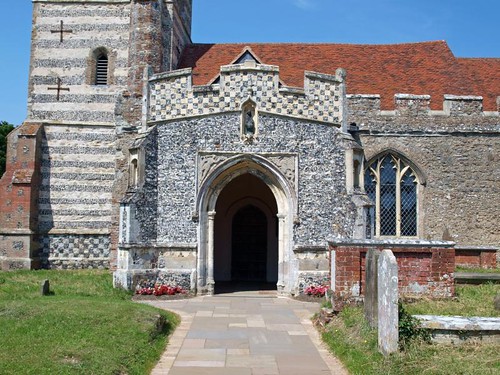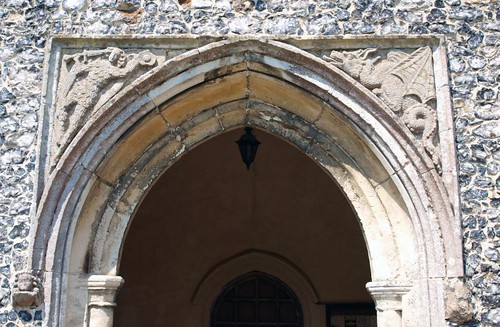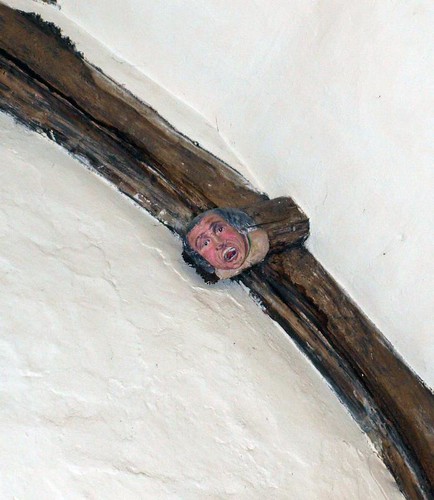The church is kept locked but is open on the first weekend of each month and between May and August on the 3rd Sunday as well. A keyholder is listed for those visiting at other times.
ST ANDREW. Visually quite exceptionally successful, owing to position, the view to the E, and the little pond with oak trees below to the W, and also to upkeep. The merit is that of not having done too much. A slight impression of neglect can be an asset. The nave is Norman, see the quoins on the N side and one complete and one fragmentary window (discovered in 1928), all with much Roman brick. Tower, S aisle and chancel C14. The tower has bands of stone and flint, flint and stone chequerwork at the base, added brick buttresses only below, and above a parapet but not battlements. Flint S porch with battlements of stone and flint chequer. Embattled S aisle. Large red, tiled roofs. White and plain interior. The S arcade is no more than a cutting of pointed arches through the Norman S wall. - FONT-COVER. Tall, octagonal, of wood, much repaired. Buttresses with pinnacles at the angles. Plain panels between ending in traceried heads. Plain second stage. Top stage with openwork ogee ribs carrying a finial. - DOOR in the S doorway, traceried, C14, badly preserved. - PAINTINGS. Unusually much still visible, even if only faintly. The most interesting remains are of a St Christopher above the N doorway, on the piers of the S arcade Virgin, St Michael and a seated Woman, Christ as Man of Sorrows. - MONUMENTS. Brass to John Alleyn, c. 1600. - George Frere d. 1655. Good frontal demi-figure, hand on a skull. In an oval niche framed by a wreath. Curly segmental pediment on top. No doubt the work of a good sculptor of the day.
FINGRINGHOE. A cheerful village on a slope of the valley of the Roman River is this, with thatched cottages and oak trees in a hollow by a pond. One of its roads runs down to a ferry across the estuary to the quaint village of Wivenhoe. Here lived the Romans; many of their red bricks are mixed with the flint and limestone rubble of the walls of the church. We come into this old place by a porch with sculptures of St Michael and the Dragon in the spandrels of its outer doorway; its inner doorway shelters a splendid 500-year-old door with the original iron handle. Stepping down into the church the eye meets on the Norman piers the paintings that stood clear in medieval times, and we can still distinguish Michael and a seated figure with long hair, wearing an ermine tippet. On the walls, too, are traces of painting of the 14th and 16th centuries. More definite are grotesque white faces grinning down from the dark beams curving round the white barrel roof. Resting on a bier of the 17th century is a hollowed-out chest much older than the date on it, and there is a great treasure of oak in the font cover, 500 years old, rising in three stages to a richly moulded terminal high above our.heads. It has carving of the greatest delicacy. There is a brass with the portraits of John Alleyn and his little daughter, in Elizabethan clothes.




No comments:
Post a Comment